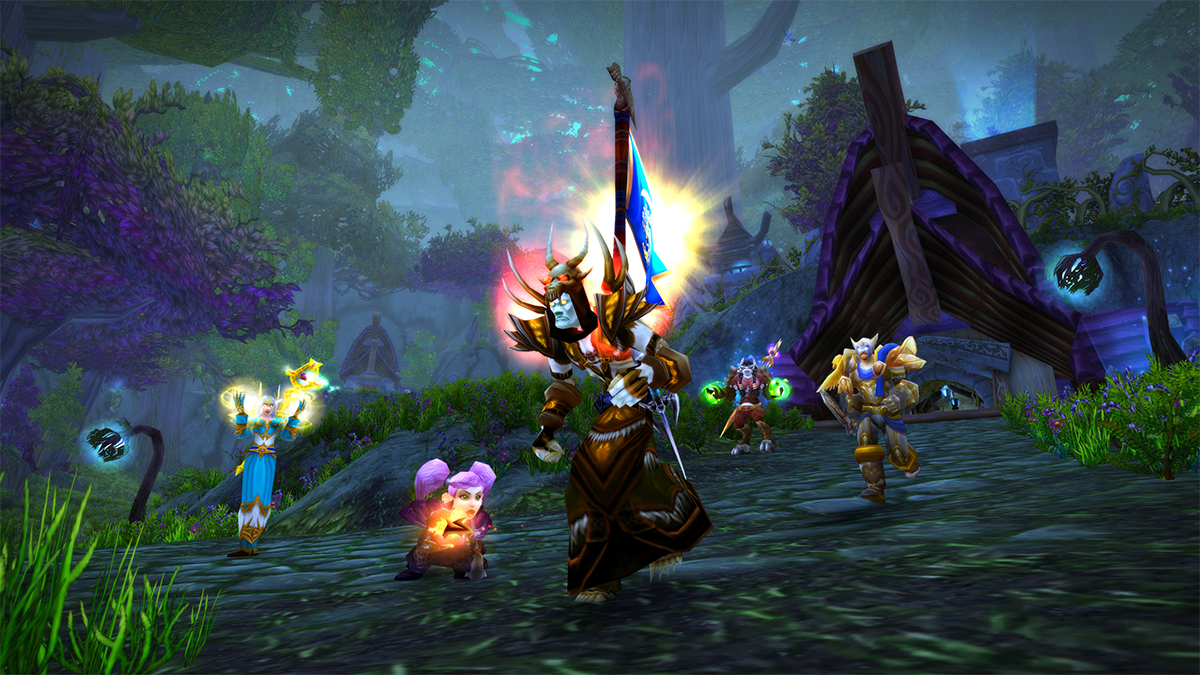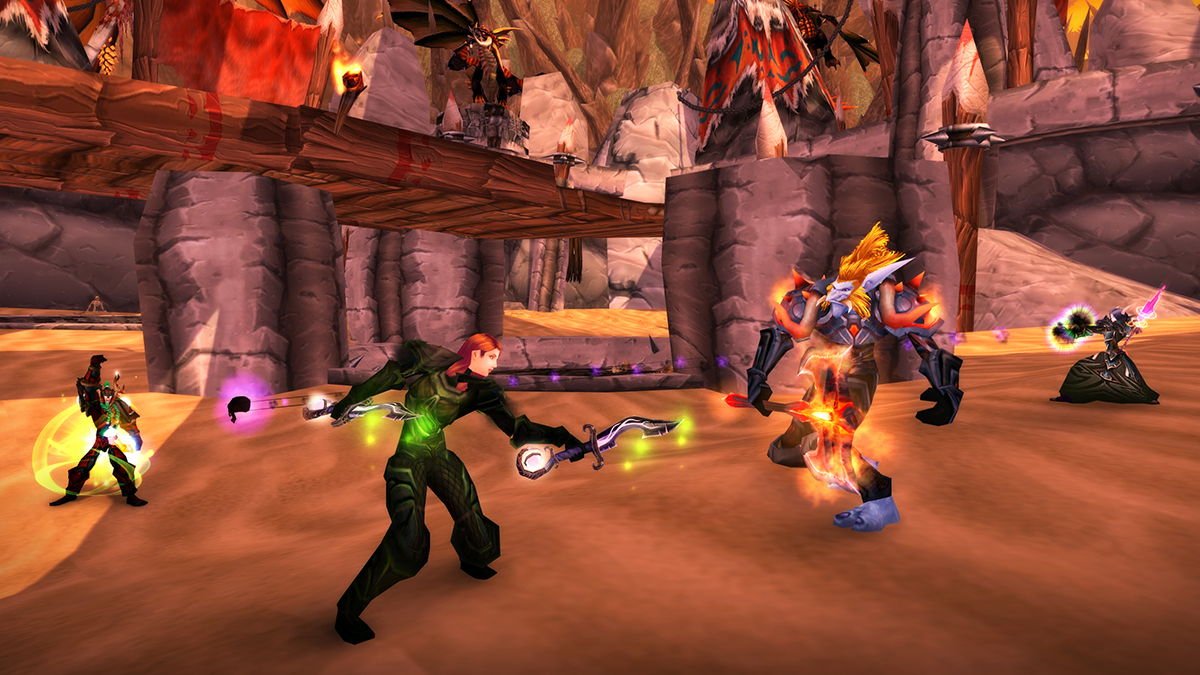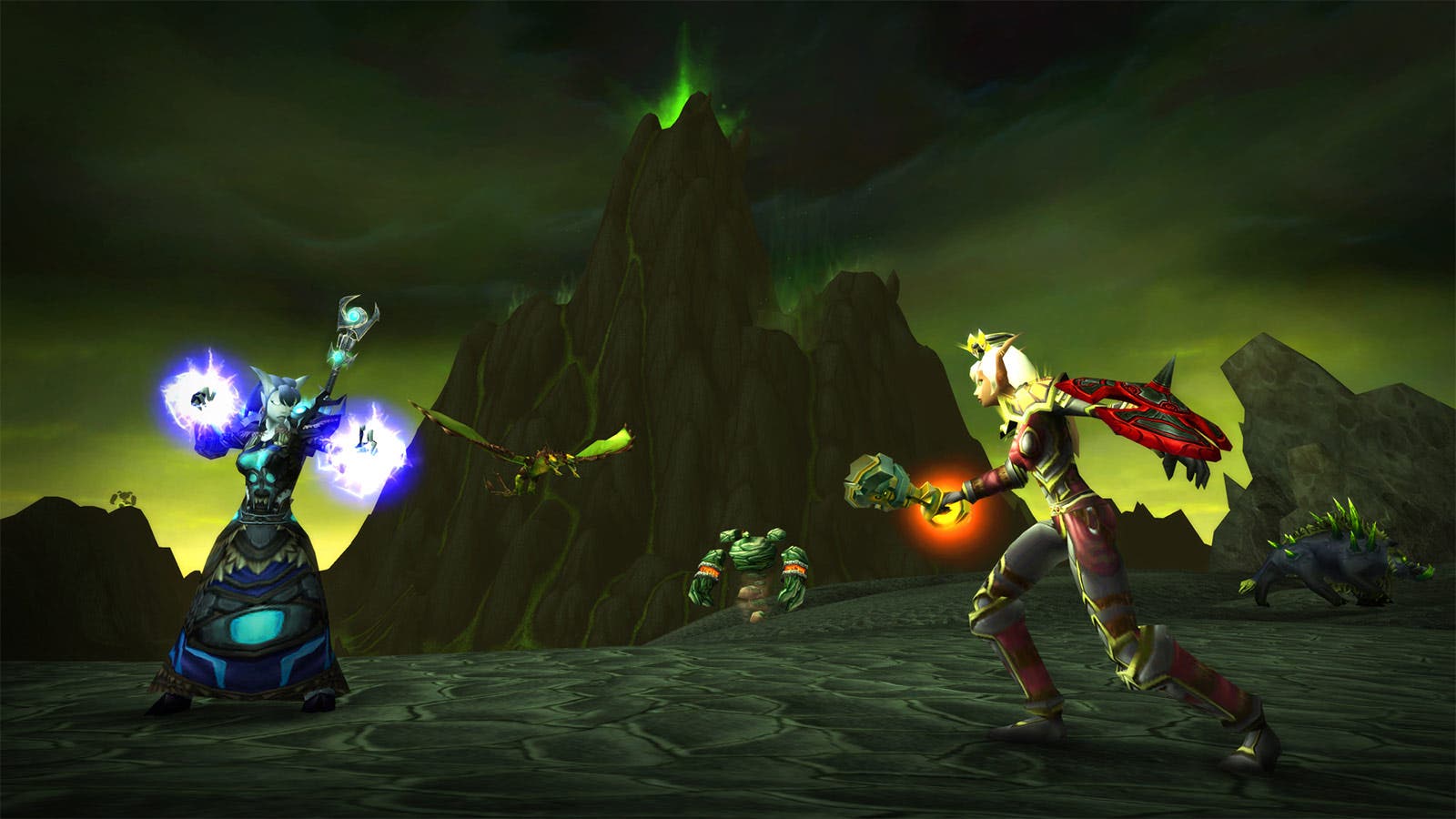The Horde is so popular in WoW: Burning Crusade Classic that it's beginning to ruin the game
World of Warcraft Classic is quickly deviating from its initial promise to be a "take it or leave it" recreation of the MMO as it existed in 2007. Since launch, Blizzard has made dozens of changes that were never in the original game. Tweaks that, while controversial to purists, were intended to find a better balance between nostalgia and what's fun in 2021.
But this weekend, World of Warcraft: Burning Crusade Classic began testing its most controversial change yet by letting players on North American servers queue up for Arena PvP matches against their own faction. It's a band-aid on what is quickly becoming one of the biggest issues with Burning Crusade Classic: No one wants to fight for the Alliance.
Zug zug
After 17 years of evolution, the neverending war between the Alliance and Horde is still World of Warcraft's defining feature. It's also the source of its most frustrating problems. Since the MMO's launch, players have effectively been divided into two groups that never interact except to fight one another. Despite how often the two factions join forces to fight a common evil in the overarching story, Horde and Alliance players have never been able to group up to take on dungeons or raids together.
This wouldn't be a problem if different races didn't each have a unique ability that could give players an edge in both PvP and PvE fights. Take the Undead ability Will of the Forsaken, for example, which grants the player instant immunity to charm, sleep, and fear effects for five seconds. In PvP fights, an ability like that gives Horde players a significant advantage—which is exactly why Undead have always been the most popular PvP race.
With Burning Crusade Classic's launch, Horde populations spiked to an average of 61 percent of all players across NA PvP servers.
In World of Warcraft Classic, these imbalances weren't such a big deal because PvP was chaotic and largely took place out in the open world or in Battlegrounds where dozens of players squared off against each other. Small advantages like that wouldn't help you against a bigger or more coordinated team. Just before Burning Crusade Classic released in June, IronForge.Pro estimated the balance between Horde and Alliance players on Classic PvP servers was almost even, with Horde being favored by just 53% of players.
But Burning Crusade's flavor of PvP is very different. One of the biggest features of this expansion is PvP Arenas, where teams of two or three players duke it out in small-scale brawls where minor differences in skill and abilities can make a huge difference. Very suddenly, WoW's PvP shifted from massive outdoor wars to intense, intimate duels. Naturally, competitive players would want every advantage they could get and, largely due to racial abilities, Horde became the de facto choice for PvP in World of Warcraft.
It's not surprising that history would repeat itself. With Burning Crusade Classic's launch, Horde populations spiked to an average of 61 percent of all players across NA PvP servers, according to estimates by IronForge.Pro. Looking at individual servers, though, that ratio can get really gruesome. Though a few do have a majority of Alliance players, most PvP servers skew toward the Horde with some, like Kirtonos and Skeram, supposedly being 100% Horde. You'd think winning the faction war would be the ultimate victory, but it's actually a nightmare for both sides.

Cycle of war
Since Burning Crusade Classic's launch, the subreddit has been dominated by complaints of long queue times for Arenas. Because most players are enlisting with the Horde, there's simply not enough Alliance arena groups to fight against, with some servers allegedly suffering hours-long waits to find a match. But Arenas aren't the only way to earn the Honor Points necessary to unlock the cool new PvP armor. So while waiting in a queue, Horde players often go prowling through different zones in Outland looking for Alliance players to gank.
As players have noted, this creates a vicious cycle in which no one wins. Alliance players trying to level up to 70 on Horde-dominated PvP servers are repeatedly being ganked by the overwhelming number of bored Horde players. Faced with such unfair odds, a lot of those players will either quit or reroll on a PvP server that favors the Alliance or switch to Classic's PvE servers where open-world PvP is opt-in. Or they'll swap sides to join the Horde.
When this happened back during Burning Crusade's official launch, the issue probably wasn't nearly as pronounced since min-maxing and theorycrafting weren't nearly as prevalent in the gaming community as they are today. But that faction imbalance steadily grew in severity until 2015 when Blizzard rolled out Mercenary Mode, a new feature that let players temporarily swap sides in Arena matches. When Mercenary Mode was activated, your avatar would be swapped out for one belonging to the opposing faction, so your opponents never even knew they were really fighting players from their own side.

As more Alliance players are inevitably drawn to the Horde (or more balanced servers), it'll create an even worse experience for the ones who remain.
This weekend, Blizzard tested a similar system for Burning Crusade Classic wherein Horde players could queue up in Arenas and, if no matches were found, would then be placed into match against another Horde group—only this time they'd be wearing cardboard masks with Alliance races painted on them instead of being magically transformed into another race.
Though the test is now over and Blizzard hasn't said whether or not the feature will be added permanently for all servers, a lot of players aren't happy with the idea of Mercenary Mode coming to Classic because it does nothing to fix the underlying issue. Of the top 25 posts on the WoW Classic subreddit last week, 13 are threads complaining about faction imbalances. A lot of players are worried this will further decimate the already small Alliance population on PvP servers.
This Reddit thread in particular sums up the problems with Blizzard's solution. While making Arenas faction agnostic will fix queue times for the Horde, it doesn't address why so few players are choosing to play Alliance. And as more Alliance players are inevitably drawn to the Horde (or more balanced servers), it'll create an even worse experience for the ones who remain. Fewer Alliance players on a server means fewer groups for dungeons and raids, less activity on the auction house, and fewer people to fight alongside in PvP.
But untying this knot isn't as simple as fixing the imbalances present in the different racial abilities. That's just one of several reasons why players tend to choose Horde. It's also a popular faction simply due to its aesthetic: undead, orcs, trolls, blood elves—there's a race that appeals to every kind of player. Blizzard has tried (unsuccessfully) to fix this by introducing more monstrous races to the Alliance side, but nothing has really shifted the needle much. And now that the imbalance has taken root, the only way to fix it would be to entice players to reroll as Alliance either by adding extra rewards or by preventing players from making new Horde characters on certain servers. But how do you get 18-year veterans to change their preferences?

During BlizzCon earlier this year—well before Burning Crusade Classic had launched—game director Ion Hazzikostas acknowledged the faction imbalance as one of the biggest problems with WoW since its original launch and even hinted that one day players might be able to group together regardless of faction. Removing these barriers separating players would be great, but it still wouldn't address the problem that, fundamentally, one faction has qualities that are more desirable. And Hazzikostas worries it might also damage the unique identity of these factions and Warcraft itself. This isn't a "Red vs Blue" multiplayer game.
It's a conundrum that becomes even more vexing in Burning Crusade Classic since it's fundamentally a recreation of an old era of WoW. Though Blizzard has been able to make some changes without much controversy, a lot of players bristle at the idea of transplanting modern features like Mercenary Mode into this old-school version of Azeroth. This controversy, and the way it has divided the playerbase, feeds into the narrative that modern WoW has lost its way because Blizzard has continually caved to players' demands to make the game more casual and accessible through features like the automatic group finder for dungeons.
Classic's enormous success hinges entirely on offering an alternative to modern WoW. For many, its extremely slow pace, emphasis on community, and grueling challenge are an exciting departure from the Pavlovian progression systems of modern WoW. But if Classic starts solving 'old' problems with modern solutions, at what point will the two MMOs become indistinguishable?
from PCGamer latest https://ift.tt/2TKGZYd
World of Warcraft Classic is quickly deviating from its initial promise to be a "take it or leave it" recreation of the MMO as it existed in 2007. Since launch, Blizzard has made dozens of changes that were never in the original game. Tweaks that, while controversial to purists, were intended to find a better balance between nostalgia and what's fun in 2021.
But this weekend, World of Warcraft: Burning Crusade Classic began testing its most controversial change yet by letting players on North American servers queue up for Arena PvP matches against their own faction. It's a band-aid on what is quickly becoming one of the biggest issues with Burning Crusade Classic: No one wants to fight for the Alliance.
Zug zug
After 17 years of evolution, the neverending war between the Alliance and Horde is still World of Warcraft's defining feature. It's also the source of its most frustrating problems. Since the MMO's launch, players have effectively been divided into two groups that never interact except to fight one another. Despite how often the two factions join forces to fight a common evil in the overarching story, Horde and Alliance players have never been able to group up to take on dungeons or raids together.
This wouldn't be a problem if different races didn't each have a unique ability that could give players an edge in both PvP and PvE fights. Take the Undead ability Will of the Forsaken, for example, which grants the player instant immunity to charm, sleep, and fear effects for five seconds. In PvP fights, an ability like that gives Horde players a significant advantage—which is exactly why Undead have always been the most popular PvP race.
With Burning Crusade Classic's launch, Horde populations spiked to an average of 61 percent of all players across NA PvP servers.
In World of Warcraft Classic, these imbalances weren't such a big deal because PvP was chaotic and largely took place out in the open world or in Battlegrounds where dozens of players squared off against each other. Small advantages like that wouldn't help you against a bigger or more coordinated team. Just before Burning Crusade Classic released in June, IronForge.Pro estimated the balance between Horde and Alliance players on Classic PvP servers was almost even, with Horde being favored by just 53% of players.
But Burning Crusade's flavor of PvP is very different. One of the biggest features of this expansion is PvP Arenas, where teams of two or three players duke it out in small-scale brawls where minor differences in skill and abilities can make a huge difference. Very suddenly, WoW's PvP shifted from massive outdoor wars to intense, intimate duels. Naturally, competitive players would want every advantage they could get and, largely due to racial abilities, Horde became the de facto choice for PvP in World of Warcraft.
It's not surprising that history would repeat itself. With Burning Crusade Classic's launch, Horde populations spiked to an average of 61 percent of all players across NA PvP servers, according to estimates by IronForge.Pro. Looking at individual servers, though, that ratio can get really gruesome. Though a few do have a majority of Alliance players, most PvP servers skew toward the Horde with some, like Kirtonos and Skeram, supposedly being 100% Horde. You'd think winning the faction war would be the ultimate victory, but it's actually a nightmare for both sides.

Cycle of war
Since Burning Crusade Classic's launch, the subreddit has been dominated by complaints of long queue times for Arenas. Because most players are enlisting with the Horde, there's simply not enough Alliance arena groups to fight against, with some servers allegedly suffering hours-long waits to find a match. But Arenas aren't the only way to earn the Honor Points necessary to unlock the cool new PvP armor. So while waiting in a queue, Horde players often go prowling through different zones in Outland looking for Alliance players to gank.
As players have noted, this creates a vicious cycle in which no one wins. Alliance players trying to level up to 70 on Horde-dominated PvP servers are repeatedly being ganked by the overwhelming number of bored Horde players. Faced with such unfair odds, a lot of those players will either quit or reroll on a PvP server that favors the Alliance or switch to Classic's PvE servers where open-world PvP is opt-in. Or they'll swap sides to join the Horde.
When this happened back during Burning Crusade's official launch, the issue probably wasn't nearly as pronounced since min-maxing and theorycrafting weren't nearly as prevalent in the gaming community as they are today. But that faction imbalance steadily grew in severity until 2015 when Blizzard rolled out Mercenary Mode, a new feature that let players temporarily swap sides in Arena matches. When Mercenary Mode was activated, your avatar would be swapped out for one belonging to the opposing faction, so your opponents never even knew they were really fighting players from their own side.

As more Alliance players are inevitably drawn to the Horde (or more balanced servers), it'll create an even worse experience for the ones who remain.
This weekend, Blizzard tested a similar system for Burning Crusade Classic wherein Horde players could queue up in Arenas and, if no matches were found, would then be placed into match against another Horde group—only this time they'd be wearing cardboard masks with Alliance races painted on them instead of being magically transformed into another race.
Though the test is now over and Blizzard hasn't said whether or not the feature will be added permanently for all servers, a lot of players aren't happy with the idea of Mercenary Mode coming to Classic because it does nothing to fix the underlying issue. Of the top 25 posts on the WoW Classic subreddit last week, 13 are threads complaining about faction imbalances. A lot of players are worried this will further decimate the already small Alliance population on PvP servers.
This Reddit thread in particular sums up the problems with Blizzard's solution. While making Arenas faction agnostic will fix queue times for the Horde, it doesn't address why so few players are choosing to play Alliance. And as more Alliance players are inevitably drawn to the Horde (or more balanced servers), it'll create an even worse experience for the ones who remain. Fewer Alliance players on a server means fewer groups for dungeons and raids, less activity on the auction house, and fewer people to fight alongside in PvP.
But untying this knot isn't as simple as fixing the imbalances present in the different racial abilities. That's just one of several reasons why players tend to choose Horde. It's also a popular faction simply due to its aesthetic: undead, orcs, trolls, blood elves—there's a race that appeals to every kind of player. Blizzard has tried (unsuccessfully) to fix this by introducing more monstrous races to the Alliance side, but nothing has really shifted the needle much. And now that the imbalance has taken root, the only way to fix it would be to entice players to reroll as Alliance either by adding extra rewards or by preventing players from making new Horde characters on certain servers. But how do you get 18-year veterans to change their preferences?

During BlizzCon earlier this year—well before Burning Crusade Classic had launched—game director Ion Hazzikostas acknowledged the faction imbalance as one of the biggest problems with WoW since its original launch and even hinted that one day players might be able to group together regardless of faction. Removing these barriers separating players would be great, but it still wouldn't address the problem that, fundamentally, one faction has qualities that are more desirable. And Hazzikostas worries it might also damage the unique identity of these factions and Warcraft itself. This isn't a "Red vs Blue" multiplayer game.
It's a conundrum that becomes even more vexing in Burning Crusade Classic since it's fundamentally a recreation of an old era of WoW. Though Blizzard has been able to make some changes without much controversy, a lot of players bristle at the idea of transplanting modern features like Mercenary Mode into this old-school version of Azeroth. This controversy, and the way it has divided the playerbase, feeds into the narrative that modern WoW has lost its way because Blizzard has continually caved to players' demands to make the game more casual and accessible through features like the automatic group finder for dungeons.
Classic's enormous success hinges entirely on offering an alternative to modern WoW. For many, its extremely slow pace, emphasis on community, and grueling challenge are an exciting departure from the Pavlovian progression systems of modern WoW. But if Classic starts solving 'old' problems with modern solutions, at what point will the two MMOs become indistinguishable?
via IFTTT

Post a Comment